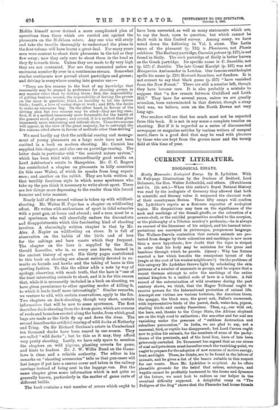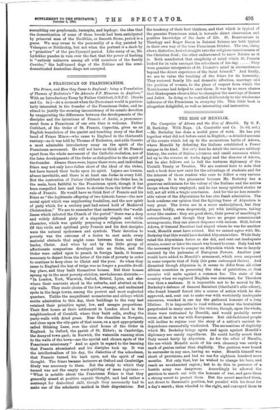C URRENT LITERATURE.
ZOOLOGICAL ESSAYS.
Mostly Mammals : Zoological Essays. By R. Lydekker. With 16 Full-page Illustrations by the Duchess of Bedford, Lord Delamere, the Hon. Walter Rothschild, and others. (Hutchinson and Co. 128. net.)—When this author's Royal Natural History was read by the zoologists of Germany they allowed that both in scientific and literary value it surpassed the classical work of their countryman Brehm. These fifty essays will confirm Mr. Lydekker's repute as a first-rate expositor of zoological topics. His disquisitions may turn on the significance of the neck and markings of the Somali giraffe, or the coloration of a cowrie-shell, or the suicidal propensities ascribed to the scorpion, or the philosophy of a Tibetan monkey's proboscis,—he is always au courant of the literature of his subject, and his learned inter- pretations are conveyed in picturesque, perspicuous language. The Wallace-Darwin contention that certain animals are pro- tected from danger by their coloration and markings is now more than a mere hypothesis ; few doubt that the tiger is striped in order that his body may be mistaken for the grass and bamboos through which he prowls. (Query : Why has Nature enacted a law which benefits the omnipotent tyrant of the jungle at the cost of his weaker neighbours ?) On the problems of this category Mr. Lydekker throws light by scheduling the skin patterns of a number of mammals in groups, and he argues that a recent German attempt to refer the markings of the entire animal kingdom to a unified code of laws is a failure. A full record of the extermination of wild creatures during the past century shows, we think, that the Hague Tribunal ought to receive powers for the International protection of animal life. Amongst our victims are various tortoises, the American bison, the quagga, the black emu, the great auk, Pallas's cormorant, with representative birds of the parrot, duck, water-hen, pigeon, starling kinds, and sundry Passerines. Then, e.g., our wild cat, the hare, and, thanks to the Congo State, the African elephant are on the high road to extinction ; the sea-otter and fur seal are vanishing under the pressure of "ruthless destruction and relentless persecution." In India, we are glad to say, not a mammal, bird, or reptile has disappeared; but Lord Curzon ought now to police his animals, for the numbers of some of the pachy- derms of the peninsula, and of the local lion, have of late been grievously curtailed. Dr. Trouessart has argued that as our stores of coal and petroleum must hereafter reach the vanishing-point, we ought to prepare for the adoption of new sources of motive energy, heat, and light. These, he thinks, are to be found in the labour of animals, and he gives a list of the beasts suitable in this respect for our wants. Here Mr. Lydekker is sceptical. As he offers plausible grounds for the belief that zebras, antelopes, and wapitis cannot be profitably harnessed to the looms and dynamos of the future, we must look to radium as our helper in the eventual difficulty supposed. A delightful essay on "The Pedigree of the Dog" shows that the Pharaohs had house frieads
resembling our greyhounds, turnspits, and lapdogs : the idea that the domestication of some of these breeds had been anticipated by primeval man of the Neolithic, or Smooth Stone, period is a guess. We may swear to the personality of a dog painted by Velasquez or Nettleship, but not when the portrait is a daub by a "primitive" of the pre-Pyramid period. Like many of us, Mr. Lydekker puzzles in vain over the fact that the power of barking is "entirely unknown among all wild members of the family Canidae," the half-tamed dogs of the Eskimo and the semi- domesticated Australian dingo not excepted.



























































 Previous page
Previous page